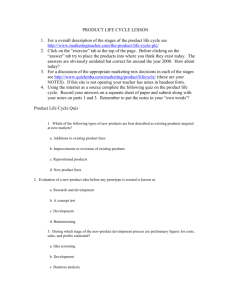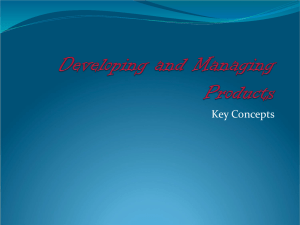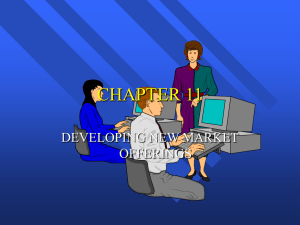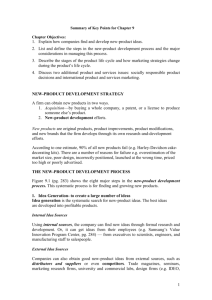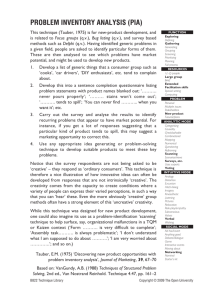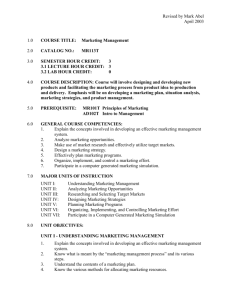CHAPTER
advertisement
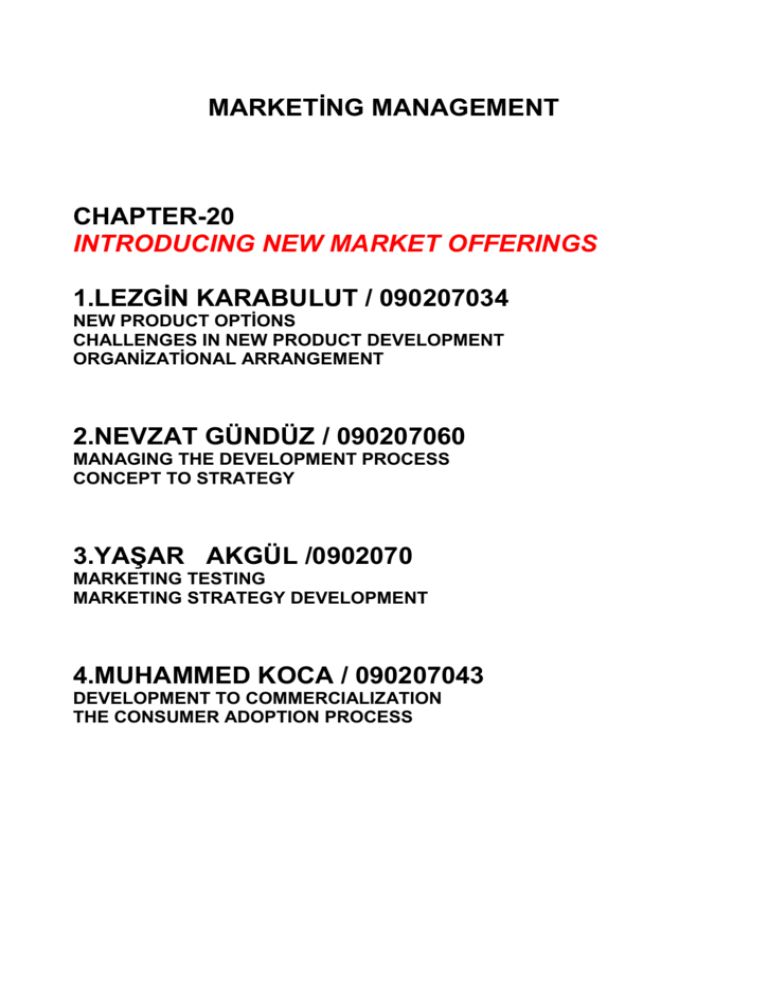
MARKETİNG MANAGEMENT CHAPTER-20 INTRODUCING NEW MARKET OFFERINGS 1.LEZGİN KARABULUT / 090207034 NEW PRODUCT OPTİONS CHALLENGES IN NEW PRODUCT DEVELOPMENT ORGANİZATİONAL ARRANGEMENT 2.NEVZAT GÜNDÜZ / 090207060 MANAGING THE DEVELOPMENT PROCESS CONCEPT TO STRATEGY 3.YAŞAR AKGÜL /0902070 MARKETING TESTING MARKETING STRATEGY DEVELOPMENT 4.MUHAMMED KOCA / 090207043 DEVELOPMENT TO COMMERCIALIZATION THE CONSUMER ADOPTION PROCESS (LEZGİN KARABULUT) CHAPTER- 20 INTRODUCING NEW MARKET OFFERINGS IN THIS CHAPTER, WE WILL ADDRESS THE FOLLOWING QUESTIONS: 1. What challenges does a company face in developing new products? 2. What organizational structures are used to manage new-product development? 3. What are the main stages in developing new products? 4. What is the best way to set up the new-product development process? 5. What factors affect the rate of diffusion and consumer adoption of newly launched products? New-Product Options and the innovation Types of new products A company can add new products through acquisition or development. The acquisition route can take three forms. The company can buy other companies, it can acquire patents from other companies, or it can buy a license or franchise from another company. Swiss food giant Nestle increased its presence in North America via its acquisition of such diverse brands as Carnation, Hills Brothers, Stouffer's, Ralston Purina, Dreyer's Ice Cream, and Chef America. The development route can take two forms. The company can develop new products in its own laboratories, or it can contract with independent researchers or new-product development firms to develop specific new products. We can identify six categories of new products: 1. New-to-the-iuorld products - New products that create an entirely new market. 2. New product lines - New products that allow a company to enter an established market for the first time. 3. Additions to existing product lines - New products that supplement established product lines (package sizes, flavors, and so on). 4. Improvements and revisions of existing products - New products that provide improved performance or greater perceived value and replace existing products. 5. Repositionings - Existing products that are targeted to new markets or market segments. 6. Cost reductions - New products that provide similar performance at lower cost. It has adopted several principles to guide its new-product development: 1. Work with potential customers. Its thoracic graft, designed to combat heart disease, was developed in close collaboration with physicians. 2. Let employees choose projects. Few actual product leaders and teams are appointed. Gore likes to nurture "passionate champions" who convince others a project is worth their time and commitment. The development of the fuel cell rallied over 100 of the company's 6,000 research associates. 3. Give employees "dabble" time. All research associates spend 10 percent of their work hours developing their own ideas. Promising ideas are pushed forward and judged according to a "Real, Win, Worth" exercise. Is the opportunity real? Can we win? Can we make money? 4. Know when to let go. Sometimes dead ends in one area can spark an innovation in another. Elixir acoustic guitar strings were a result of a failed venture into bike cables. Even successful ventures may have to move on. Glide shred-resistant dental floss was sold to Procter & Gamble because Gore-Tex knew that retailers would want to deal with a company selling a whole family of health care products. Most new-product activity is devoted to improving existing products New-Product Success Most established companies focus on incremental innovation. Newer companies create disruptive technologies that are cheaper and more likely to alter the competitive space. Established companies can be slow to react or invest in these disruptive technologies because they threaten their investment. Then they suddenly find themselves facing formidable new competitors, and many fail. To ensure that they don't fall into this trap, incumbent firms must carefully monitor the preferences of both customers and noncustomers over time and uncover evolving, difficult-to-articulate customer needs. New-Product Failure At the same time, new-product development can be quite risky new products continue to fail at a disturbing rate. Recent studies put the rate at 95 percent in the United States and 90 percent in Europe. New products can fail for many reasons: ignoring or misinterpreting market research; overestimating market size; high development costs; poor design; incorrect positioning, ineffective advertising, or wrong price; insufficient distribution support; and competitors who fight back hard. Several factors also tend to hinder new-product development: Shortage of important ideas in certain areas. There may be few ways left to improve some basic products (such as steel or detergents). Fragmented markets. Companies have to aim their new products at smaller market segments, and this can mean lower sales and profits for each product. Social and governmental constraints. New products have to satisfy consumer safety and environmental concerns. Cost of development. A company typically has to generate many ideas to find just one worthy of development, and often faces high R&D, manufacturing, and marketing costs. Capital shortages. Some companies with good ideas cannot raise the funds needed to research and launch them. Faster required development time. Companies must learn how to compress development time by using new techniques, strategic partners, early concept tests, and advanced marketing planning. Shorter product life cycles. When a new product is successful, rivals are quick to copy it. Sony used to enjoy a three-year lead on its new products. Now Matsushita will copy the product within six months, leaving hardly enough time for Sony to recoup its investment. Organizational Arrangements Once a company has carefully segmented the market, chosen its target customers, identified their needs, and determined its market positioning, it is better able to develop new products. Many companies today use customer-driven engineering to design new products. Customer-driven engineering attaches high importance to incorporating customer preferences in the final design. New-product development requires senior management to define business domains, product categories, and specific criteria. General Motors has a hefty $400 million benchmark it must apply to new car models—this is what it costs to get a new vehicle into production. One company established the following acceptance criteria: The product can be introduced within five years. The product has a market potential of at least $50 million and a 15 percent growth rate. The product would provide at least 30 percent return on sales and 40 percent on investment. The product would achieve technical or market leadership. Budgeting for New-Product Development Senior management must decide how much to budget for new-product development. R&D outcomes are so uncertain that it is difficult to use normal investment criteria. Some companies solve this problem by financing as many projects as possible, hoping to achieve a few winners. Other companies apply a conventional percentage of sales figures or spend what the competition spends. Still other companies decide how many successful new products they need and work backward to estimate the required investment Organizing New-Product Development Companies handle the organizational aspect of new-product development in several ways. Many companies assign responsibility for new-product ideas to product managers. But product managers are often so busy managing existing lines that they give little thought to new products other than line extensions. They also lack the specific skills and knowledge needed to develop and critique new products. Kraft and Johnson & Johnson have newproduct managers who report to category managers. Some companies have a Iiigh-level management committee charged with reviewing and approving proposals. Large companies often establish a new-product department headed by a manager who has substantial authority and access to top management. The department's major responsibilities include generating and screening new ideas, working with the R&D department, and carrying out field testing and commercialization. Cross-functional teams help to ensure that engineers are not just driven to create a "better mousetrap" when potential customers do not really need or want one. Some possible criteria for staffing cross-functional new-product venture teams include: Desired team leadership style and level of expertise. The more complex the newproduct concept, the greater the desired expertise. Team member skills and expertise. New-venture teams for Aventis, part of pharmaceutical, agricultural, and chemical conglomerate, contain people with expertise in chemistry, engineering, market research, financial analysis, and manufacturing. Level of interest in the particular new-product concept. Is there interest or, even better, a high level of ownership and commitment (a "concept champion")? Potential for personal reward. What motivates individuals to want to participate in this effort? Diversity of team members. This includes race, gender, nationality, breadth of experience, depth of experience, and personality. The greater the diversity, the greater the range of viewpoints and decision-making potential. (NEVZAT GÜNDÜZ) Managing the Development Process New Product Idea Generation The first step of new product development requires gathering ideas to be evaluated as potential product options. For many companies idea generation is an ongoing process with contributions from inside and outside the organization. Many market research techniques are used to encourage ideas including: running focus groups with consumers, channel members, and the company’s sales force; encouraging customer comments and suggestions via toll-free telephone numbers and website forms; and gaining insight on competitive product developments through secondary data sources. One important research technique used to generate ideas is brainstorming where open-minded, creative thinkers from inside and outside the company gather and share ideas. The dynamic nature of group members floating ideas, where one idea often sparks another idea, can yield a wide range of possible products that can be further pursued. INTERACTING WİTH OTHER Many firms are increasingly going outside the company to tap external sources of new ideas,40 including customers, employees, scientists, engineers, channel members, marketing agencies, top management, and even competitors. "Marketing Insight: P&G's New Connect-and-Develop Approach to Innovation" describes how that company has become more externally focused in its newproduct development. Customer needs and wants are the logical place to start the search.41 One-on-one interviews and focus-group discussions can explore product needs and reactions. Griffin and Hauser suggest that conducting 10 to 20 in-depth experiential interviews per market segment often uncovers the vast majority of customer needs.42 But many additional approaches can be profitable CREATIVITY TECHNIQUES Morphological Analysis This method is another product improvement technique, permitting the in-depth analysisof products or processes. It involves applying a set of words to an item another set of words. Normally, one set of words is verbs and the other set are attributes of the product.Another way is that one set of words would be components of the product (breaking the product down into its parts) and the other set of words would be alternative solutions.The method is to combine each word of one set with each word of the other set. These two sets of words result in a two-dimensional matrix. A three dimensional matrix can be created by adding a third list of factors. The difficulty of this technique is the large number of ideas deriving of the multiple combinations that can be made. Mind Mapping It is an individual brainstorming mapping technique designed by Tony Buzan. It begins with a central focal point, a problem, an object, a name or issue, written in the centre of a piece of paper with a circle around it. Each major facet of the problem or the solution to the problem originating from the central idea is then brainstorming in order to generate new ideas. Each of those ideas are then written on lines drowned outward from the circle. The next step is to brainstorm those ideas in order to identify issues related to the problem, or solutions that are written on smaller lines that are drowned on the prime lines forming a branch. Additional perspectives such as implementation factors or further definition of the solutions could go on those lines. One branch may also be chosen in order to develop a whole new mind map based on that branch. When a mind map is completed, its possible interrelations and possible multiple appearances of issues, and its overall meaning in the context of the problem must be examined. Attribute listing List the attributes ofan object, such as a screwdriver. Then modify each attribute, such as replacing the wooden handle with plastic, providing torque power, adding different screw heads, and so on. Forced relationships List several ideas and consider each in relation to each other idea. In designing new office furniture, for example, consider a desk, bookcase, and filing cabinet as separate ideas. Then imagine a desk with a built-in bookcase or a desk with built-in files or a bookcase with built-in files. Reverse assumption analysis List all the normal assumptions about an entity and then reverse them. Instead of assuming that a restaurant has menus, charges for food, and serves food, reverse each assumption. The new restaurant may decide to serve only what the chef bought that morning and cooked; may provide some food and charge only for how long the person sits at the table; and may design an exotic atmosphere and rent out the space to people who bring their own food and beverages. New contexts Take familiar processes, such as people-helping services, and put them into a new context. Imagine helping dogs and cats instead of people with day care service, stress reduction, psychotherapy, animal funerals, and so on. As another example, instead of sending hotel guests to the front desk to check in, greet them at curbside and use a wireless device to register them. Idea Screening In Step 2 the ideas generated in Step 1 are critically evaluated by company personnel to isolate the most attractive options. Depending on the number of ideas, screening may be done in rounds with the first round involving company executives judging the feasibility of ideas while successive rounds may utilize more advanced research techniques. As the ideas are whittled down to a few attractive options, rough estimates are made of an idea’s potential in terms of sales, production costs, profit potential, and competitors’ response if the product is introduced. Acceptable ideas move on to the next step. Managing the Development Process: Concept to Strategy Concept Development and Testing With a few ideas in hand the marketer now attempts to obtain initial feedback from customers, distributors and its own employees. Generally, focus groups are convened where the ideas are presented to a group, often in the form of concept board presentations and not in actual working form. For instance, customers may be shown a concept board displaying drawings of a product idea or even an advertisement featuring the product. In some cases focus groups are exposed to a mock-up of the ideas, which is a physical but generally non-functional version of product idea. During focus groups with customers the marketer seeks information that may include: likes and dislike of the concept; level of interest in purchasing the product; frequency of purchase and price points to determine how much customers are willing to spend to acquire the product. Conjoint Analysis Is a statistical technique used in market research to determine how people value different features that make up an individual product or service.The objective of conjoint analysis is to determine what combination of a limited number of attributes is most influential on respondent choice or decision making. A controlled set of potential products or services is shown to respondents and by analyzing how they make preferences between these products, the implicit valuation of the individual elements making up the product or service can be determined. These implicit valuations (utilities or part-worths) can be used to create market models that estimate market share, revenue and even profitability of new designs. (YAŞAR ) Marketing Strategy Marketing strategies serve as the fundamental underpinning of marketing plans designed to fill market needs and reach marketing objectives. Plans and objectives are generally tested for measurable results. Commonly, marketing strategies are developed as multiyear plans, with a tactical plan detailing specific actions to be accomplished in the current year. Time horizons covered by the marketing plan vary by company, by industry, and by nation, however, time horizons are becoming shorter as the speed of change in the environment increases. Marketing strategies are dynamic and interactive. They are partially planned and partially unplanned. Marketing strategy involves careful scanning of the internal and external environments. Internal environmental factors include the marketing mix, plus performance analysis and strategic constraints. External environmental factors include customer analysis, conpetitors analysis and target market analysis, as well as evaluation of any elements of the technological, economic, cultural or political/legal environment likely to impact success. A key component of marketing strategy is often to keep marketing in line with a company's overarching mission statement. Business Analysis Business analysis as a discipline has a heavy overlap with requrements analysis sometimes also called requirements engineering, but focuses on identifying the changes to an organization that are required for it to achieve strategic goals. These changes include changes to strategies, structures, policies, processes, and information systems. Estimate likely selling price based upon competition and customer feedback Estimate sales volume based upon size of market and such tools as the FourtWoodlock equation Estimate profitability and break-even point ESTIMATING TOTAL SALES Total estimated sales are the sum of estimated first-time sales, replacement sales, and repeat sales. Sales-estimation methods depend on whether the product is a one-time purchase (such as an engagement ring or retirement home), an infrequently purchased product, or a frequently purchased product. For one-time purchased products, sales rise at the beginning, peak, and later approach zero as the number of potential buyers is exhausted (see Figure 20.6 [a]). If new buyers keep entering the market, the curve will not go down to zero. ESTIMATING COSTS AND PROFITS Costs are estimated by the R&D, manufacturing, marketing, and finance departments. Table 20.3 illustrates a five-year projection of sales, costs, and profits for the instant breakfast drink. Row 1 shows the projected sales revenue over the five-year period. The company expects to sell $11,889,000 (approximately 500,000 cases at $24 per case) in the first year. Behind this sales projection is a set of assumptions about the rate of market growth, the company's market share, and the factory-realized price. Row 2 shows the cost of goods sold, which hovers around 33 percent of sales revenue. This cost is found by estimating the average cost of labor, ingredients, and packaging per case. Row3 shows the expected gross margin, which is the difference between sales revenue and cost of goods sold. Managing the Development Process: Development to Commercialization Up to now, the product has existed only as a word description, a drawing, or a prototype. This next step involves a jump in investment that dwarfs the costs incurred in the earlier stages. At this stage the company will determine whether the product idea can be translated into a technically and commercially feasible product. If it cannot, the accumulated project cost will be lost except for any useful information gained in the process. Product Development The job of translating target customer requirements into a working prototype is helped by a set of methods known as quality function deployment (QFD). The methodology takes the list of desired customer attributes (CAs) generated by market research and turns them into a list of engineering attributes (EAs) that the engineers can use. For example, customers of a proposed truck may want a certain acceleration rate (CA). Engineers can turn this into the required horsepower and other engineering equivalents (EAs). The methodology permits the measuring of the trade-offs and costs of providing the customer requirements. A major contribution of QFD is that it improves communication between marketers, engineers, and the manufacturing people PHYSICAL PROTOTYPES The R&D department will develop one or more physical versions of the product concept. Its goal is to find a prototype that embodies the key attributes described in the product-concept statement, that performs safely under normal use and conditions, and that can be produced within the budgeted manufacturing costs. Developing and manufacturing a successful prototype can take days, weeks, months, or even years. Sophisticated virtual-reality technology is now speeding the process. By designing and testing product designs through simulation, for example, companies achieve the flexibility to respond to new information and to resolve uncertainties by quickly exploring alternatives. CUSTOMER TESTS When the prototypes are ready, they must be put through rigorous functional tests and customer tests. Alpha testing is the name given to testing the product within the firm to see how it performs in different applications. After refining the prototype 40 further, the company moves to beta testingwith customers. It enlists a set of customers to use the prototype and give feedback. Table 20.4 shows some of the functional tests products go through before they enter the marketplace. Consumer preferences can be measured in several ways. Suppose a consumer is shown three items—A, B, and C, such as three cameras, three insurance plans, or three advertisements. The rank-order method asks the consumer to rank the three items in order of preference. The consumer might respond with A>B>C. Although this method has the advantage of simplicity, it does not reveal how intensely the consumer feels about each item nor whether the consumer likes any item very much. It is also difficult to use this method when there are many objects to be ranked. The paired-comparison method calls for presenting pairs of items and asking the consumer which one is preferred in each pair. Thus the consumer could be presented with the pairs AB, AC, and BC and say that she prefers A to B, A to C, and B to C. Then we could conclude that A>B>C. People find it easy to state their preference between two items, and this method allows the consumer to focus on the two items, noting their differences and similarities. The monadic-rating method asks the consumer to rate liking of each product on a scale. Suppose a seven-point scale is used, where 1 signifies intense dislike,4 indiffer ence, and 7 intense like. Suppose the consumer returns the following ratings: A=6, B = 5, C=3. We can derive the individual's preference order (i.e., A>B>C), and even know the qualitative levels of the person's preference for each and the rough distance between preferences. Market Testing After management is satisfied with functional and psychological performance, the product is ready to be dressed up with a brand name and packaging, and put into a market test. The new product is introduced into an authentic setting to learn how large the market is and how consumers and dealers react to handling, using, and repurchasing the product. Not all companies undertake market testing. A company officer at Revlon, Inc., stated: "In our field—primarily higher-priced cosmetics not geared for mass distribution—it would be unnecessary for us to market test. When we develop a new product, say an improved liquid makeup, we know it's going to sell because we're familiar with the field. And we've got 1,500 demonstrators in department stores to promote it." Many companies, however, believe that market testing can yield valuable information about buyers, dealers, marketing program effectiveness, and market potential. The main issues are: How much market testing should be done, and what kind(s)? CONSUMER-GOODS MARKET TESTING In testing consumer products, the company seeks to estimate four variables: trial, first repeat, adoption, and purchase frequency. The company hopes to find all these variables at high levels. In some cases, it will find many consumers trying the product but few rebuying it; or it might find high permanent adoption but low purchase frequency (as with gourmet frozen foods). Here are four major methods of consumer-goods market testing, from the least to the most costly. Sales-Wave Research In sales-wave research, consumers who initially try the product at no cost are reoffered the product, or a competitor's product, at slightly reduced prices. Simulated Test Marketing Simulated test marketing calls for finding 30 to 40 qualified shoppers and questioning them about brand familiarity and preferences in a specific product category. These people are then invited to a brief screening of both well-known and new commercials or print ads. Controlled Test Marketing In this method, a research firm manages a panel of stores that will carry new products for a fee. The company with the new product specifies the number of stores and geographic locations it wants to test. Test Markets The ultimate way to test a new consumer product is to put it into full-blown test markets. The company chooses a few representative cities, and the sales force tries to sell the trade on carrying the product and giving it good shelf exposure. Management faces several decisions: 1. How many test cities? Most tests use between two and six cities. The greater the maximum possible loss, the greater the number of contending marketing strategies, the greater the regional differences, and the greater the chance of test-market interference by competitors, the greater the number of cities that should be used. 2. Which cities?'Each company must develop selection criteria such as having good media coverage, cooperative chain stores, and average competitive activity. 3. Length of test? Market tests last anywhere from a few months to a year. The longer the average repurchase period, the longer the test period. 4. What information?'Warehouse shipment data will show gross inventory buying but will not indicate weekly sales at the retail level. Store audits will show retail sales and competitors' market shares but will not reveal buyer characteristics. Consumer panels will indicate which people are buying which brands and their loyalty and switching rates. Buyer surveys will yield in-depth information about consumer attitudes, usage, and satisfaction. 5. What action to take? tf the test markets show high trial and repurchase rates, the product should be launched nationally; if they show a high trial rate and a low repurchase rate, the product should be redesigned or dropped; if they show a low trial rate and a high repurchase rate, the product is satisfying but more people have to try it. This means increasing advertising and sales promotion. If trial and repurchase rates are both low, the product should be abandoned. (MUHAMMED KOCA) BUSİNESS-GOOD MARKET TESTİNG: Business goods can also benefit from market testing. Expensive industrial goods and new technologies will normally undergo alpha testing (within the company) and beta testing (with outside customers). During beta testing, the vendor's technical people observe how test customers use the product, a practice that often exposes unanticipated problems of safety and servicing and alerts the vendor to customer training and servicing requirements. The vendor can also observe how much value the equipment adds to the customer's operation as a clue to subsequent pricing. The vendor will ask the test customers to express their purchase intention and other reactions after the test. Vendors must carefully interpret the beta test results because only a small number of test customers are used, they are not randomly drawn, and the tests are somewhat customized to each site. Another risk is that test customers who are unimpressed with the product may leak unfavorable reports about it. Commercialization If the company goes ahead with commercialization, it will face its largest costs to date. The company will have to contract for manufacture or build or rent a full-scale manufacturing facility. Plant size will be a critical decision. When Quaker Oats launched its 100 Percent Natural breakfast cereal, it built a smaller plant than called for by the sales forecast. The demand so exceeded the forecast that for about a year it could not supply enough product to stores. Although Quaker Oats was gratified with the response, the low forecast cost it a considerable amount of profit. WHEN (TIMING) In commercializing a new product, market-entry timing is critical. Suppose a company has almost completed the development work on its new product and learns that a competitor is nearing the end of its development work. The company faces three choices: 1. First entry - The first firm entering a market usually enjoys the "first mover advantages" of locking up key distributors and customers and gaining leadership. But if the product is rushed to market before it is thoroughly debugged, the first entry can backfire. 2. Parallel entry - The firm might time its entry to coincide with the competitor's entry. The market may pay more attention when two companies are advertising the new product. 3. Late entry -The firm might delay its launch until after the competitor has entered. The competitor will have borne the cost of educating the market, and its product may reveal faults the late entrant can avoid. The late entrant can also learn the size of the market. WHERE(GEOGRAPHIC STRATEGY):The company must decide whether to launch the new product in a single locality, a region, several regions, the national market, or the international markex. Mo&t will ete-vetno a. ip(aimed naajckat rollout, aver time. CocaCola launched its new soda, Citra, a caffeine-free, grapefruit-flavored drink, in about half the United States. The multistaged rollout, following test marketing in Phoenix, southern 45 Texas, and southern Florida, began in January 1998 in Dallas, Denver, and Cincinnati. Company size is an important factor here. Small companies will select an attractive city and put on a blitz campaign. They will enter other cities one at a time. Large companies will introduce their product into a whole region and then move to the next region. Companies with national distribution networks, such as auto companies, will launch their new models in the national market. TO WHOM (TARGET-MARKET PROSPECTS) Within the rollout markets, the company must target its initial distribution and promotion to the best prospect groups characteristics: They would be early adopters, heavy users, and opinion leaders, and they could be reached at a low cost. Few groups have all these characteristics. The company should rate the various prospect groups on these characteristics and target the best group. The aim is to generate strong sales as soon as possible to attract further prospects. HOW (INTRODUCTORY MARKET STRATEGY) The company must develop an action plan for introducing the new product into the rollout markets. In 1998, Apple Computer staged a massive marketing blitz to launch the iMac, its reentry into the computer PC business after a hiatus of 14 years. Five years later, Apple struck gold again with the launch of the iPod. The Consumer-Adoption Process Adoption is an individual's decision to become a regular user of a product. How do potential customers learn about new products, try them, and adopt or reject them? The consumer-adoption process is later followed by the consumer-loyalty process, which is the concern of the established producer. Years ago, new-product marketers used a mass-market approach to launch products. This approach had two main drawbacks: It called for heavy marketing expenditures, and it involved many wasted exposures. These drawbacks led to a second approach, heavy-user target marketing. This approach makes sense, provided that heavy users are identifiable and are early adopters. However, even within the heavy-user group, many heavy users are loyal to existing brands. Newproduct marketers now aim at consumers who are early adopters. Stages in the Adoption Process An innovation is any good, service, or idea that is perceived by someone as new. The idea may have a long history, but it is an innovation to the person who sees it as new. Innovations take time to spread through the social system. Rogers defines the innovation diffusion process as "the spread of a new idea from its source of invention or creation to its ultimate users or adopters. The consumer-adoption process focuses on the mental process through which an individual passes from first hearing about an innovation to final 51 adoption. Adopters of new products have been observed to move through five stages: 1. Awareness -The consumer becomes aware of the innovation but lacks information about it. 2. Interest-The consumer is stimulated to seek information about the innovation. 3. Evaluation -The consumer considers whether to try the innovation. 4. Trial-The consumer tries the innovation to improve his or her estimate of its value. 5. Adoption -The consumer decides to make full and regular use of the innovation. The new-product marketer should facilitate movement through these stages. A portable electric-dishwasher manufacturer might discover that many consumers are stuck in the interest stage; they do not buy because of their uncertainty and the large investment cost. But these same consumers would be willing to use an electric dishwasher on a trial basis for a small monthly fee. The manufacturer should consider offering a trial-use plan with option to buy. Factors Influencing the Adoption Process Marketers recognize the following characteristics of the adoption process: differences in individual readiness to try new products; the effect of personal influence; differing rates of adoption; and differences in organizations' readiness to try new products. READINESS TO TRY NEW PRODUCTS AND PERSONAL INFLUENCE Everett Rogers defines a person's level of innovativeness as "the degree to which an individual is relatively earlier in adopting new ideas than the other members of his social system." In each product area, there are pioneers and early adopters. Some people are the first to adopt new clothing fashions or new appliances; some doctors are the first to prescribe new medicines; and some farmers are the first to adopt new farming methods. People can be classified into the adopter categories shown in Figure 20.7. After a slow start an increasing number of people adopt the innovation, the number reaches a peak, and then it diminishes as fewer non-adopters remain. The five adopter groups differ in their value orientations and their motives for adopting or resisting the new product. Innovators are technology enthusiasts; they are venturesome and enjoy tinkering with new products and mastering their intricacies. In return for low prices, they are happy to conduct alpha and beta testing and report on early weaknesses. Early adopters are opinion leaders who carefully search for new technologies that might give them a dramatic competitive advantage. They are less price sensitive and willing to adopt the product if given personalized solutions and good service support. Early majority are deliberate pragmatists who adopt the new technology when its benefits are proven and a lot of adoption has already taken place. They make up the mainstream market. Late majority are skeptical conservatives who are risk averse, technology shy, and price sensitive. Laggards are tradition-bound and resist the innovation until they find that the status quo is no longer defensible. Each of the five groups must be approached with a different type of marketing if the firm wants to move its innovation through the full product life cycle. Personal influence is the effect one person has on another's attitude or purchase probability. Although personal influence is an important factor, its significance is greater in some situations and for some individuals than for others. CHARACTERISTICS OF THE INNOVATION Some products catch on immediately (rollerblades), whereas others take a long time to gain acceptance (diesel engine autos). Five characteristics influence the rate of adoption of an innovation. We will consider them in relation to the adoption of personal video recorders (PVRs) for home use, as exemplified byTiVo. The first is relative advantage—the degree to which the innovation appears superior to existing products. The greater the perceived relative advantage of using a PVR, say, for easily recording favorite shows, pausing live TV or skipping commercials, the more quickly it will be adopted.The second is compatibility—the degree to which the innovation matches the values and experiences of the individuals. PVRs, for example, are highly compatible with avid television watchers. Third is complexity—the degree to which the innovation is relatively difficult to understand or use. PVRs are somewhat complex and will therefore take a slightly longer time to penetrate into home use. Fourth is divisibility—the degree to which the innovation can be tried on a limited basis. This provides a sizable challenge for PVRs—sampling can only occur in a retail store or perhaps a friend's house. Fifth is communicability—the degree to which the beneficial results of use are observable or describable to others. The fact that PVRs have some clear advantages can help create interest and curiosity. Other characteristics that influence the rate of adoption are cost, risk and uncertainty, scientific credibility, and social approval. The new-product marketer has to research all these factors and give the key ones maximum attention in designing the new-product and marketing program. ORGANIZATIONS' READINESS TO ADOPT INNOVATIONS The creator of a new teaching method would want to identify innovative schools. The producer of a new piece of medical equipment would want to identify innovative hospitals. Adoption is associated with variables in the organization's environment (community progressiveness, community income), the organization itself (size, profits, pressure to change), and the administrators (education level, age, sophistication). Other forces come into play in trying to get a product adopted into organizations that receive the bulk of their funding from the government, such as public schools. A controversial or innovative product can be squelched by negative public opinion. QUESTIONS 1. Most new-product activity is devoted to ________ existing products. a. improving b. coordinating c. distributing d. pricing e. marketing 2. The new-product development process starts with the search for ________. a. production efficiency b. products that can be improved upon c. overseas products d. ideas e. strategy 3. Company ________ and intermediaries are a particularly good source of ideas. These groups have firsthand exposure to customers and are often the first to learn about competitive developments. a. marketing departments b. competitors c. sales representatives d. top management e. customers 4. A company should motivate its employees to submit new ideas to a(n) ________, whose name and phone number are widely circulated. a. idea manager b. senior product manager c. creative manager d. advertising manager e. top management person 5. Consumer preferences for alternative product concepts can be measured through _________, a method for deriving the utility values that consumers attach to varying levels of a product’s attributes. a. marketing strategy b. marketing research c. gap level d. conjoint analysis e. purchase intentions 6. a. b. c. d. e. 7. a. b. c. d. e. 8. a. b. c. d. e. 9. a. b. c. d. e. The business attractiveness of a proposal is dependent on ________. sales projections cost projections profit projections all of the above none of the above Companies use financial measures to evaluate the merit of a new-product proposal. The simplest to use is called ________ , in which management estimates how many units of the product the company would have to sell to break even with the given price and cost structure. conjoint analysis risk analysis regression analysis ANOVA analysis breakeven analysis In consumer-goods market testing, the company seeks to estimate four variables. These four variables are: trial, first repeat, adoption, and ________. money-back guarantee price purchase frequency usage preferences A(n) ________ is any good, service, or idea that is perceived as new, no matter how long its history. product innovation new idea creative product none of the above 10. _________ is the effect one person has on another’s attitude or purchase probability. a. b. c. d. e. Effective influence Direct influence Market influence Brand influence Personal influence
